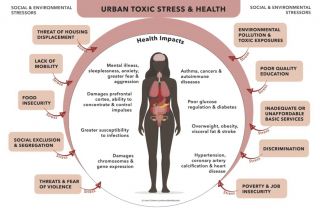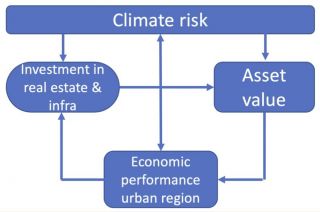
www.buildingsandcities.org/insights/commentaries/cop26-building-passports.html
Why Digital Building Passports Are Vital for Change

By Thomas Lützkendorf (Karlsruhe Institute of Technology, DE), Ursula Hartenberger (PathTo2050, BE), York Ostermeyer (Chalmers U, SE)
COP-26 is about showcasing action and replicable, practical solutions that will accelerate market transformation. Climate action must become incorporated into the regular activities of the construction and real estate sectors. The way to achieve this is to incentivise a systematic and transparent approach to building-related information which can accelerate and reward stakeholder action. The building passport can accomplish this by creating a "living document". In first instance, governments should set an example by making building passports mandatory for public buildings and then consecutively roll it out across other building typologies and market segments.
A shift is needed from energy performance certificates (EPCs) to the more holistic approach of a building passport concept. The provision of accessible and high-quality information will enable optimised maintenance, refurbishment and general maintenance planning. It will reduce energy and material flows, extend the useful life span of the building and support circular economy principles. Among the performance criteria in question, carbon performance is undoubtedly extremely urgent.
In order to accelerate the decarbonisation of the building stock, carbon performance as a "hidden" characteristic of buildings must be appropriately reflected in stakeholders' decision-making and their data and information exchange with others.
Today's discussions about the carbon performance of buildings bear all the hallmarks of past discussions in Europe when energy performance was also a "hidden" building characteristic. The subsequent introduction of EPCs was aimed at "unveiling" this hidden characteristic and at motivating owners to improve the energy performance of their buildings.
The roll-out of EPCs was transformative. EPCs made it possible for both developers and vendors to signal the energy performance of properties to third parties (signalling) and for prospective buyers or tenants to specifically search for corresponding properties with above-average energy performance (screening). This type of performance signalling and screening substantially reduces adverse selections caused by non-transparent, asymmetrical information.
However, at present energy performance certificates are still mainly used for transactions, i.e. renting or selling, and they ignore embodied energy (despite its significant share in the total energy consumption, especially in new buildings). Most importantly, EPCs are mostly static documents rather than a dynamic holistic reflection of a building's history, condition and options for the future.
That raises the questions of whether it is sufficient to solely look at energy performance in transactions and to only focus on the operation of the building. Even if EPCs were to be expanded with information on GHG emissions, their ability to influence stakeholder activities and decision-making remains limited.
This is why a "digital building passport" has an important role: an extensive, continuously updated property information repository that accompanies the whole building life cycle and allows data and information sharing with value chain stakeholders. A detailed definition has been developed by the authors together with a dedicated stakeholder task force in the framework of a practical guideline for building passports prepared for the UNEP Global Alliance for Buildings and Construction.
As part of a digital building passport, energy consumption and other primary data can be gathered, evaluated and analysed to determine the actual GHG emissions and other pollutants during operation. The bill of materials / material inventory will support the life cycle based approach. Also results of life cycle based LCA can be "stored" in the building passport and updated during/after refurbishment.
Housing companies already link this type of information within their sustainability reporting.
A digital building passport would broaden the group of participants to include individual building owners and thus have a wide impact. This allows all those involved in the real estate sector the opportunity (i) to monitor their building's performance and (ii) to create a process of continuous improvement toward (net) zero carbon.
The widespread adoption of the passport will facilitate market transformation through information sharing and improved information flows. It will help owners and other stakeholders to monitor progress towards mitigation targets.
At present most digital building passports are voluntary. Some are market-led, others are government-led. Government-led schemes clearly ensure impact and will create a harmonised approach. In first instance, governments should set an example by making it mandatory for public buildings to have a digital building passport and then consecutively roll it out across other building typologies and market segments.
References
European Commission. (2002). Directive 2002/91/EC of the Europen Parliament and of the Council of 16 December 2002 on the energy performance of buildings. Official Journal of the European Communities, 4.1.2003, L 1/65. https://bit.ly/3jdlVmI
European Commission. (2013). Energy performance certificates in buildings and their impact on transaction prices and rents in selected EU countries. Paris: Bio Intelligence Service. https://bit.ly/30EbylB
European Commission. (2021). Study on the development of an EU framework for digital building logbooks. Luxembourg: Publications Office of the EU. https://bit.ly/3DUKpt8
Global Alliance for Buildings and Construction & the UN Environment Progamme. (2021). The building passport: a tool for capturing whole life data in construction and real estate - practical guidelines. Nairobi: UNEP. https://bit.ly/3lNT8qG
Latest Peer-Reviewed Journal Content
A framework for 1.5°C-aligned GHG budgets in architecture
G Betti, I Spaar, D Bachmann, A Jerosch-Herold, E Kühner, R Yang, K Avhad & S Sinning
Net zero retrofit of the building stock [editorial]
D Godoy-Shimizu & P Steadman
Co-learning in living labs: nurturing civic agency and resilience
A Belfield
The importance of multi-roles and code-switching in living labs
H Noller & A Tarik
Researchers’ shifting roles in living labs for knowledge co-production
C-C Dobre & G Faldi
Increasing civic resilience in urban living labs: city authorities’ roles
E Alatalo, M Laine & M Kyrönviita
Co-curation as civic practice in community engagement
Z Li, M Sunikka-Blank, R Purohit & F Samuel
Preserving buildings: emission reductions from circular economy strategies in Austria
N Alaux, V Kulmer, J Vogel & A Passer
Urban living labs: relationality between institutions and local circularity
P Palo, M Adelfio, J Lundin & E Brandão
Living labs: epistemic modelling, temporariness and land value
J Clossick, T Khonsari & U Steven
Co-creating interventions to prevent mosquito-borne disease transmission in hospitals
O Sloan Wood, E Lupenza, D M Agnello, J B Knudsen, M Msellem, K L Schiøler & F Saleh
Circularity at the neighbourhood scale: co-creative living lab lessons
J Honsa, A Versele, T Van de Kerckhove & C Piccardo
Positive energy districts and energy communities: how living labs create value
E Malakhatka, O Shafqat, A Sandoff & L Thuvander
Built environment governance and professionalism: the end of laissez-faire (again)
S Foxell
Co-creating justice in housing energy transitions through energy living labs
D Ricci, C Leiwakabessy, S van Wieringen, P de Koning & T Konstantinou
HVAC characterisation of existing Canadian buildings for decarbonisation retrofit identification
J Adebisi & J J McArthur
Simulation and the building performance gap [editorial]
M Donn
Developing criteria for effective building-sector commitments in nationally determined contributions
P Graham, K McFarlane & M Taheri
Reimagining circularity: actions for optimising the use of existing buildings
R Lundgren, R Kyrö, S Toivonen & L Tähtinen
Effective interdisciplinary stakeholder engagement in net zero building design
S Vakeva-Baird, F Tahmasebi, JJ Williams & D Mumovic
Metrics for building component disassembly potential: a practical framework
H Järvelä, A Lehto, T Pirilä & M Kuittinen
The unfitness of dwellings: why spatial and conceptual boundaries matter
E Nisonen, D Milián Bernal & S Pelsmakers
Environmental variables and air quality: implications for planning and public health
H Itzhak-Ben-Shalom, T Saroglou, V Multanen, A Vanunu, A Karnieli, D Katoshevski, N Davidovitch & I A Meir
Exploring diverse drivers behind hybrid heating solutions
S Kilpeläinen, S Pelsmakers, R Castaño-Rosa & M-S Miettinen
Urban rooms and the expanded ecology of urban living labs
E Akbil & C Butterworth
Living with extreme heat: perceptions and experiences
L King & C Demski
A systemic decision-making model for energy retrofits
C Schünemann, M Dshemuchadse & S Scherbaum
Modelling site-specific outdoor temperature for buildings in urban environments
K Cebrat, J Narożny, M Baborska-Narożny & M Smektała
Understanding shading through home-use experience, measurement and modelling
M Baborska-Narożny, K Bandurski, & M Grudzińska
Building performance simulation for sensemaking in architectural pedagogy
M Bohm
Beyond the building: governance challenges in social housing retrofit
H Charles
Heat stress in social housing districts: tree cover–built form interaction
C Lopez-Ordoñez, E Garcia-Nevado, H Coch & M Morganti
An observational analysis of shade-related pedestrian activity
M Levenson, D Pearlmutter & O Aleksandrowicz
Learning to sail a building: a people-first approach to retrofit
B Bordass, R Pender, K Steele & A Graham
Market transformations: gas conversion as a blueprint for net zero retrofit
A Gillich
Resistance against zero-emission neighbourhood infrastructuring: key lessons from Norway
T Berker & R Woods
Megatrends and weak signals shaping future real estate
S Toivonen
A strategic niche management framework to scale deep energy retrofits
T H King & M Jemtrud
Generative AI: reconfiguring supervision and doctoral research
P Boyd & D Harding
Exploring interactions between shading and view using visual difference prediction
S Wasilewski & M Andersen
How urban green infrastructure contributes to carbon neutrality [briefing note]
R Hautamäki, L Kulmala, M Ariluoma & L Järvi
Implementing and operating net zero buildings in South Africa
R Terblanche, C May & J Steward
Quantifying inter-dwelling air exchanges during fan pressurisation tests
D Glew, F Thomas, D Miles-Shenton & J Parker
Western Asian and Northern African residential building stocks: archetype analysis
S Akin, A Eghbali, C Nwagwu & E Hertwich
Join Our Community

The most important part of any journal is our people – readers, authors, reviewers, editorial board members and editors. You are cordially invited to join our community by joining our mailing list. We send out occasional emails about the journal – calls for papers, special issues, events and more.
We will not share your email with third parties. Read more



Latest Commentaries
COP30 Report
Matti Kuittinen (Aalto University) reflects on his experience of attending the 2025 UN Conference of the Parties in Belém, Brazil. The roadmaps and commitments failed to deliver the objectives of the 2025 Paris Agreement. However, 2 countries - Japan and Senegal - announced they are creating roadmaps to decarbonise their buildings. An international group of government ministers put housing on the agenda - specifying the need for reduced carbon and energy use along with affordability, quality and climate resilience.
Building-Related Research: New Context, New Challenges
Raymond J. Cole (University of British Columbia) reflects on the key challenges raised in the 34 commissioned essays for Buildings & Cities 5th anniversary. Not only are key research issues identified, but the consequences of changing contexts for conducting research and tailoring its influence on society are highlighted as key areas of action.